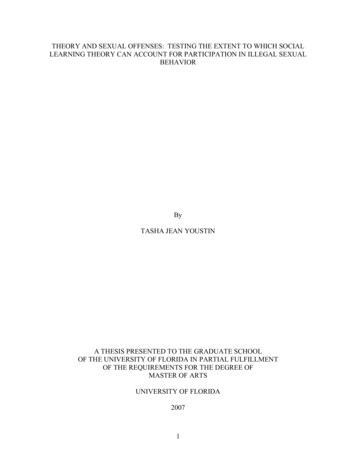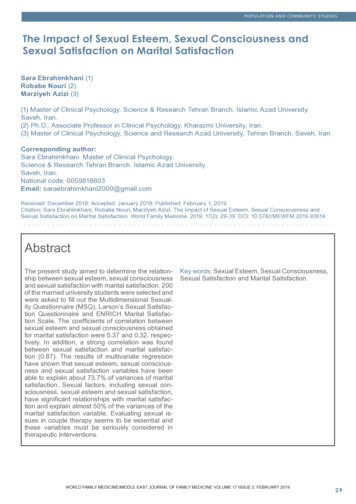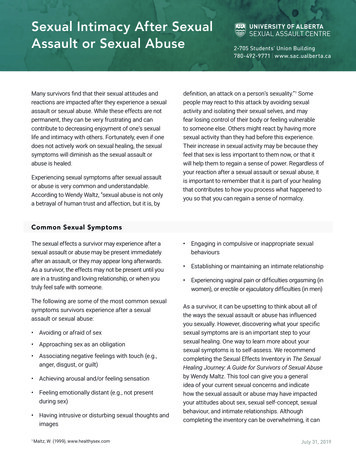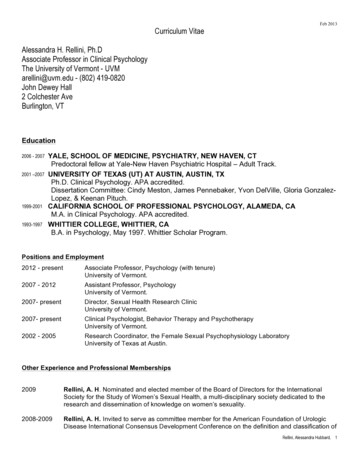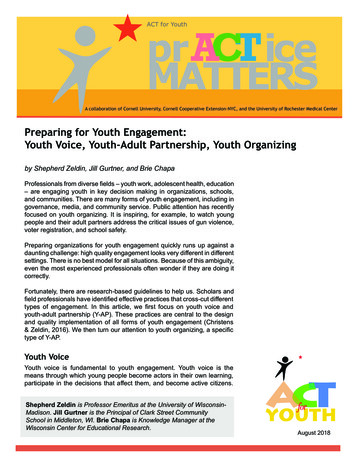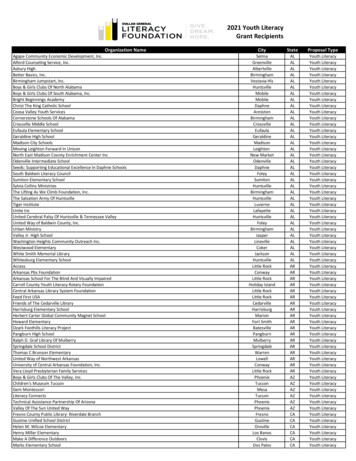
Transcription
If you have issues viewing or accessing this file contact us at NCJRS.gov.REPORT TO THE MICHIGAN LEGISLATURESEXUAL OFFENSES BY YOUTHIN MICHIGANDATAJ[MJPLJ[ CA 1'1 0 NSAND I.,POLlCY RECOMMENDAHON§
SEXUAL OFFENSES BY YOUTHIN MICHIGAN:A DDATA,IMPLICATIONS,POLICY RECOMMENDATIONS\January, 1988NCJRSMAY 26 1988Researched and written byMichigan Adolescent Sexual Abuser ProjectK. Jill Farrell and Bob O'Brien, CoordinatorsThis study was conducted under a contract with the Michigan State Department of Mental HealthTom Watkins, DirectorPublished by Safer Society Resources of Michigan1035 St. AntoineDetroit, MI 48226(313) 965-4136
111465U.S. Department of JusticeNational institute of JusticeThis document has been reproduced exactly as received from theperson or organization originating it. Points of view or opinions statedin thil document are those of the authors and do not necessarilyrepresllnt the official position or pOlicies of the National Institute ofJustice.Permission 10 reproduce this copyrighted material has beengranted bySaTer Society Resourcesof 1ichigan r Inc.to l'1e National Criminal Justice Reference Service (NCJRS).Further reproduction outside of the NCJRS system requires permission of the copyright owner.,I,I
EXECUTIVE SUMMARYI1986 DATA:PROFILE OF JUVENILE SEX OFFENDERS IN MICHIGAN*o There were 681 identified juvenile sex offenders in the state.;1o 96% were males.('.) The median age of these offenders was 14.o The median ?ge of their victims was 7.(\) Acts of penetration were the most common sex offenses, accounting for 56% of the total.o 93% of the offenders were acquaintances, friends, babysitters, or relatives of the victims.RECOMMENDATIONS TO THE MICHIGAN LEGISLATUREServiceso The Michigan Legislature should legislate policies developing a centinuum of care servicedelivery system for adolescent sexual abusers, including outpatient, day-care, residential,and secure residential treatment.Planningo The Michigan Legislature should sponsor a Multi-Agency Task Force on Adolescent SexualAbusers to identify service providers and trainers in the state, coordinate policy, developprotocol, establish training for early intervention, and develop new services where existingproviders are unwilling or unable to provide adequate services to juvenile sex offenders."*Throughout this report, the terms "Adolescent Sexual Abusers," "Juvenile Sex Offenders, 11and "Youth Who Sexually Abuse" are used interchangeably.
a,xMichigan Adolescent Sexual Abuser Project'f{ "1';::-'· }' fH5·"O,,,J§!Wf@@MA§?iS@ii#tlft8Mrn3i?*&l5 i#WMiii?Wf1iS&A49 W#i* 'iM-',i#MidiMf!l§At*HiWiWZtJPURPOSE OF THE STUDYThe purpose of collecting and reporting this data on adolescents who sexually abuse inMichigan is to educate policy makers about the scope of this problem, in order for it to besystematically addressed. Our conviction and evidence is that with proper identification,intervention, and treatment, juvenile sex offenders can learn positive behaviors, thuspreventing a new generation of adult sex offenders and sexual-assault victims.In keeping with this purpose, this report includes Recommendations for Legislative Action.These recommendations are based on the new information about these youth: their offenses andtreatment and the risk they pose to the community if allowed to go untreated. Therecommendations listed below are consistent with the work produced by other task forcesdealing with juvenile crime issues. Every effort has been made to complement and use existingstructures rather than creating new ones.HistoryIn 1974, the Michigan Legislature passed into law the nation's first criminal sexual conductcode which broadened definitions of rape and reformed court procedures by restricting the useof a victim's sexual history as evidence for the defense. In the 14 years since that time, thepervasiveness of a previously hidden problem has been made apparent by the increasingwillingness of victims to report incidents of sexual assault. Official statistics, court data, generalpopUlation surveys, and self-reports of sex offenders offer new and compelling evidence about thescope of sexual victimization.An examination of the adult sex offender population in Michigan'S prisons refk cts thescope of the problem. There were 502 adjudicated adult sex offenders in prison in 1974, comprisingjust over 5% of the population. Today there are more than 2,400 sex offenders in Michigan prisons,and they account for 14% of the total prison population. A very conservative estimate is thatMichigan taxpayers spend 46 minion dollars to house adult sex offenders for one year. (1)Research conducted on 411 nonincarcerated sex offenders by Dr. Gene Abel and Dr. JudithBecker offers an unprecendented rationale for early intervention with sex offenders. Half of theadult offenders in the study experienced deviant sexual arousal as adolescents. On the average,each of the 232 child molesters in the study had attempted nearly 240 molestations and hadcompleted nearly 170 molestations on 75 different victims. Rapists self-reported that they hadcommitted 7.5 assaults on the average. (2)(1)Gall R Ugh!, ad, "Mk! igan Department of Corrections 1985 Annual Report," pp. 24·32 and pp. 55·57 (Michigan Department of Corrections, 1986) Cost perprisoner from personal communication with Robert Brown, Jr., Director of the Michigan Department of Corrections, January 20, 1988. Computations by SaferSOCiety Resources of Michigan.(2)G. G. Abel, M.S. Mittleman, and J.V. Becker, "Sexual Offenders: Results of Assessments and Recommendations for Treatment," in Clinlcnl Criminology.ads.M. H. Ben·Aron, S. J. Hucker, and C. D. Webster (TorontC', M. M. Graphics, 1985) pp. 192-193.ii
Michigan Adolescent Sexual Abuser ProjectThe loss incurred by Michigan's citizens, families, and communities through sexualvictimizations is incalculable. Indeed, many offenders have themselves been sexually abused.This is one of the tragic effects of sexual assault: the cycle of victimization.As you read the following pages, you will see that there are nearly 700 identified adolescentsexual abusers in the Michigan juvenile system. * The Michigan Adolescent Sexual AbuserProject surveyed Juvenile Courts, the Department of Social Services, and the State Policeto determine the numbers of juvenile sex offenders in Michigan, the nature of their ofIenses,and the policy needs to prevent future sex offenses by this population.The scope of these offenses, reported here for the first time, can provide the impetus forMichigan to both plan for prevention of sex offenses committed by adolescents and to helpyouth cunrrently in the system change their assaultive behaviors.Without e:il'fective intervention with juvenile sex offend rs, the numbers of victims willrise.*The youth included in this study are sexual abusers who have been identified by the police, investigated and referred to Juvenile Court, and processedthrough the Court system. The researchers of this report have reason to believe that sexual offenses by adolescents are stili considerably underreported.iii
CONTENTS1fIfr(Nature of the Study by Representative Joe Young, Sr. . . .Statewide Advisory Board and Policy Work Group .3Recommendations to the Michigan Legislature5Services . . 5PlanningCost Analysis:7Specialized Outpatient Treatment for Juvenile Sex Offenders .9Results of the Study on Sexual Offenses by Youth in Michigan . . . . . . . . . . . . . . 10Research Methods . . 10Survey of Court Juvenile Officers and Department of Social ServicesCommunity Service Workers . 11Survey of County Department of Social Services Children'sProtective Services Supervisors . 17Survey of Michigan State Police Post Community Service Officers . . . . . . . . . 20Sex-Offense Specific Treatment for Juvenile Sex Offenders . 22Assumptions of Sex-Offender Treatment Specialists Nationally . 22Current Services in Michigan . 24Treatn:ent Outcomes . 24Conclusion . 25About the Project . . . .
,.,HOUSE OF REPRESENTATIVESLANSING; MICHIGANJOE YOUNG, SR.'I'", ,.:,J ;;'; t i.STATE CAPITOL ,, Pi 'f!I:'rnT'rrLANSING, MICHIGAN 48909: .'MEMBER OF COMMITTEE ONAPPROPRIATIONSSUBCOMMITTEES:'""","TELEPHONE: (5171373-1776MENTAL HEALTH. CHAIRMANGENERAL GOVERNMENT AND RETIREMENTJanuary , 1988SOCIAL SERVICESCOMMUNITY COLLEGESCORRECTIONSENERGYDear Friends:NATUREOF THESTUDYIn the fall of 1985, the Michigan Department of Mental Healthcontracted with the Michigan Adolescent Sexual Abuser Project to conduct astudy of youth in Michigan who are known to have sexually abused others. TheProject collected information on the nature of offenses, the victims ofthese offenses, and the capability Michigan possesses to intervene in orderto prevent further sexual victimization.This report was developed with the assistance of the MichiganLegislature, the House Mental Health Standing Committee, and the HouseAppropriations Subcommittee on Mental Health. Tom Watkins, Director of theDepartment of Mental Health, and Pat Babcock, former Director, both of whomare members of the Governor's Human Services Cabinet, provided consistentleadership and support for the study and this report.In order to compile the report, surveys were unaertaken of thefollowing dedicated Michigan professionals: Children's Protective Service Supervisors Michigan State Police Post Community Service Officers Court Juvenile Officers and Directors Department of Social Services Community Service WorkersWe owe a great deal of gratitude to these workers, who go unnamed in thisreport, and to the other professionals involved in the tedious and oftenpainful reporting, investigating, casework, and policy making involved injuvenile sex offenses.Throughout Michigan, there are hard-working professionals who have beenproviding services to adolescent sexual abusers for years While advocatingfor the expansio , of specialized services. Unfortunately, such serviceshave been under-staffed and under-funded; some parts of the state and someagencies are especially lacking in services to adolescent sexual abusers,with the result that same sexually aggressive youth do not receivespecialized intervention. Currently no standards exist in Michigan for theidentification, assessment, and treatment of sex offenders. Such standardsneed to be developed as part of an ongoing statewide effort to reduce sexualvictimization through adolescent sexual abuser treatment.The work that has produced this report has been guided and facilitatedby the Statewide Advisory Board and the Policy Recommendations Work Group on
Page TwoAdolescent Sexual Abusers. They have provided a strong base of expertiseand support from which to approach the very serious problem of sexualaggression by Michigan youth. Along with their organizations, they arenamed below. We are fortunate in Michigan for their persistent good workand for the accomplishment of the Project.sittiberely,J.JY:biE YOUNG, SR.tate Representative4th District
ADVISORY BOARDThe Advisory Board guided the work of the Project and made tremendous contributions in every aspectof the work - data collection, policy recommendations, and editing this report.Adolf ArmbrusterMDSS/OCYSP.O. Box 30037Lansing, MI 48909(517) 373-8225Hon. Randall J. HekmanJuvenile Court Center1501 Cedar St., N.E.Grand Rapids, MI 49503(616) 774-3708Bill PatrickDept. of Social ServicesP.O. Box 30037Lansing, M I 48909(517) 335-4504C. Patrick Babcock, DirectorSue JohnsonDepartment of Mental HealthLewis Cass Bldg.6th FloorLansing, MI 48926(517) 335-0276Carole QuartermanMayor's Task Force on CAN -CCCCD5031 GrandyDetroit, MI 48211(313) 579-2777Michigan Dept. of Social ServicesCommerce BuildingLansing, MI 48909(517) 373-2000Char BeedleIonia County C.M.H Center437 W. LincolnIonia, MI 48846(616) 527-1790Barbara A. ConsilioOakland County Juvenile Court1200 N. Telegraph Rd.Pontiac, MI 48098(313) 858-0950Kathleen Coulborn-FallerIPCAN - U of M Social Work Center1015 E. HuronAnn Arbor, MI 48109(313) 763-3785Barbara J. Crozier125 Ottawa Ave., N.W.Suite 250Grand Rapids, MI 49503Laura DanielOCYS/MDSS300 S. Capitol, Suite 90 ILansing, M I 48909(517) 373-6221J. Otis DavisState Court Administrator's OfficeP.O. Box 30048Lansing, M I 48909(517) 373-4835Cindy L. DoyleSt. Joseph Co. DSSP.O. Box 159, M-86 E.Centreville, M I 49032(616) 467-6311Wolfgang EggersMaxey Training SchoolP.O. Box 349Whitmore Lake, MI 48189(313) 449-2910Gloria GillespieAssault Recovery Associates303 RidgewaySt. Joseph, M I 49085(616) 983-5285Lisa KaichenChildren's Charter115 W. AlleganSuite 500Lansing, MI 48933(517) 482-7533Barbara ReedParents Anonymous of Michigan1553 WoodwardSuite 541Detroit, MI 48226(313) 237-0943Phil McPeekSW Detroit C.M.H.1700 WatermanDetroit, MI 48209(313) 841-8905Susan ScheurerDept. Of Public Health3500 N. Logan StreetP.O. Box 30035Lansing, M 1 48909(517) 335-8929David C. MillsChildren's Trust FundP.O. Box 30026Lansing, MI 48909(517) 373-4320Tom Sovine, DirectorMental Health Association in Michigan15920 W. 12 Mile Rd.Southfield, MI 48076(313) 557-6777Audrey MinorChildren's Center101 E. AlexandrineDetroit, M I 4820 I(313) 831-5535Luke StephanLutheran Child & Family ServicesP.O. Box 48Bay City, MI 48707(517) 686-7650Carol T. MowbrayDept. of Mental HealthLewis Cass Bldg.6th FloorLansing, MI 48926(517) 373-3628Sgt. Sandra K. ThompsonMichigan State Police714 S. Harrison Rd.E. Lansing, MI 48823(517) 337-6171Michael MurphySt. of Mich. Executive OfficeCapitol BuildingLansing, MI 48909(517) 373-3427Sandra MurphyParents Anonymous of Michigan1553 WoodwardSuite 541Detroit, MI 48226(313) 237-0943Gerald NesterSpecial Education ServicesP.O. Box 30008Lansing, MI 48909(517) 373-1695-3-Paul VanderVeldeDept. Of Mental HealthLewis Cass Bldg.Lansing, MI 48926(517) 373-0451John WeiksKent Co. Juvenile Court Ctr.1501 Cedar St., N.E.Grand Rapids, MI 49503(616) 774-3749Rep. Joe Young, Sr.State CapitolRoom 7Lansing, MI 48909(517) 373-1776
POLICY RECOMMENDATIONSWORKGROUPGenelle AllenMichigan Protection & AdvocacyP.O. Box 206Northville, MI 48167\.Margaret AlstonHouse Fiscal AgencyP.O. Box 30036Lansing, MI 48909(517) 373-8080Jeff Butts810 DeweyAnn Arbor, MI 48104(313) 936-1766Fred ChappellIonia County LS.D.2190 Harwood Rd.Ionia, MI 48846(616) 527-4900IsabeIJe Das-GuptaHawthorne CenterP.O. Box 349Whitmore Lake, MI 48189(313) 449-4422Betty DaveyHouse Democratic Staff772 Roosevelt Bldg.P.O. Box 30014Lansing, MI 48909(517) 373-9178Jacki DavidMichigan Protection and Advocacy109 W. Michigan AvenueSuite 900Lansing, MI 48933(517) 487-1755Jeanine DavisRep. Joe Young, Sr., StaffState Capitol, Room 7Lansing, MI 48909(517) 373-9891Diane Emling, DirectorOffice of Children & Youth ServicesMichigan Department of Social ServicesLansing, MI 48909Debbie FrederickS.A.I.N. of MichiganP.O. Box 20112Lansing, MI 48901(517) 371-7140Harry Gret:terGratiot - Isabella LS.D.1131 E. Center St.Ithaca, MI 48847(517) 875-5101David KochMidland County Probate Court1348 S. GenevaShepherd, MI 48883(517) 832-6890Chris Lobanov-RostovskyChildren's Center101 E. AlexandrineDetroit, MI 48201(313) 831-5535Nancy LockhartMichigan Protection and AdvocacyP.O. Box 206Northville, MI 48167(313) 455-9580Pat MainoProgect START1035 St. AntoineDetroit, MI 48226(313) 965-3517Judith A. SmithIngham County Health Dept.5303 S. Cedar St.P.O. Box 30161LansiD.g, MI 48909(517) 887-6997Teressa StatenBureau of Educational ServicesMichigan Dept. of EducationP.O. Box 30008Lansing, MI 48909(517) 373-6723Vic Weipert, Budget DirectorMichigan Dept. of Social ServicesCommerce Center Bldg.P.O. Box 30036Lansing, MI 48909(517) 373-2440Doug WiseMacomb-Oakland Regional Center16200 19 Mile Rd.Mt. Clemells, MI 48044(313) 286-8400Larry D. MiesnerMDSSjOCYS300 S. Capitol AvenueLansing, MI 48909(517) 373-2046Hon. Donald S. OwensIngham County Probate Court303 W. Kalamazoo StreetSuite 300Lansing, MJ 48933(517) 485-1751Jurlge V. Robert PayantState Court AdministratorP.O. Box 30048Lansing, MI 48909(517) 373-0130David J. Potts200 S. MainThree Rivers, MI 49093(616) 279-9536Carol SlottkeDMHjMaxey Mental Health UnitP.O. Box 349Whitmore Lake, MI 48189(313) 449-4422-4-Preoaration of the data and thestatistical analysis for this reportwas done byJeff uttsSchool of Social WorkUniversity Of Michigan(313) 665-4041andRick HoeferSchool of Social WorkUniversity of Michigan(313) 747-0457
Preventing Sexual Ass2alllt ThroughAdolescent Sexual Abuser Treatment:A STATEWIDE ACTION PLANThis actlon plan ha been developed by private and public sector representativeswho are committed to the goal of preventing sexual assault victimizations. Afterreviewing the Michigan data and much of the national literature regarding juvenile sexoffenders, these representatives worked together to frame a statewide action plan. This planhas two components, Legislative Recommendations and Departmental Management PlanRecommendations. *LEGISLATIVE RECOMMENDATIONSLISERVICESThe Michigan legisiahue ::»hould legislate policies developing a "CONTINUUM OFCARE SERViCE-DELIVERY SYSTEM" for adolescent se}{ual abusers.A. WE RECOMMEND THAT THE MICHIGAN LEGISLATURE MANDATE SpecializedDiagnostic Assessment of Each Juvenile Sex Offender in Michigan. )In order to determine the risk to the community and the type of treatment needed,each juvenile sex offender must have a pre-disposition diagnostic assessment thatis sex-offender specific.Assessments must include a prognosis for treatment and a recommendation forplacement. Placembnt should be based on the level of risk the offender poses tothe community both short and long-term.(') Each county must have access to both community-based and residential diagnosticcenters which conduct sex-offense specific assessments.'1o Funds must be available for transportation and (where applicable) housing costsfor families of juvenile sex offenders to enable them to participate in the assessment.Family assessment is a key component of this diagnostic process.*The State Departments and Offices of Education, Mental Health, Public Health, Social Services, State Police, and SupremeCourt have each received Management Plan Recommendations. A copy of the Management Plan Recommendations isavailable through Safer Society Resources of Michigan.
B. WE RECOMMEND THAT THE MICHIGAN LEGISLATURE REVIEW THEDEPARTMENTAL MANAGEMENT PLAN RECOMMENDATIONS AND MANDATE aComprehensive Service-Delivery System with Of Continuum of Care Which Includesthe. Following Services:1. Community-Based Education/Treatment Programs2. Community Outpatient Programs3. Day Treatment Programs (24-hour supervision)4. Group Homes and Child-Care Centers (Community-Based)5. Locked Residential Treatment FacilitiesThis system of care is guided by these principles: )Treatment orientation should be consistent throughout the system, whilerecognizing that different placements require shifts in techniques, objectives, orstrategies.o Every effort should be made to establish and maintain a youth's relationships withstaff and peers as s/he moves along the continuum from residential tocommunity treatment.o Placement policies must allow the youth to move in either direction along thecontinuum; this movement to a more restrictive or less restrictive setting shouldoccur by order of the court.C. WE RECOMMEND THAT THE MICHIGAN LEGISLATURE MANDATE a SystemWhich Includes Specific Programs to Treat Sexual Offenders with Major Emotionaland/or Developmental Impairments, i.e., Mentally III, Developmentally Delayed,and Emotionally Disturbed Youth.-6-
III.PLANNINGThe Michigan Legislature should sponsor, assure funds for, and participate in anAdolescent Se}{ual Abuser Task Force and assign to it the following membership andresponsibilities:o All State Departments and Offices Involved in Human Services and Law EnforcementWill Assign One or More Members to the Task Forces Including:Department of CorrectionsEducationMental HealthPublic HealthSocial ServicesState PoliceOffice of Attorney GeneralGovernorSupreme CourtIIIThis Task Force will identify service providers who presently operate any of thecomponents of juvenile treatment who desire to provide services to juvenile sexoffenders. In areas where services do not exist or providers are unwilling or unable toprovide adequate services to sex offenders, new providers will have to be sought.o The Task Force will identify people who will serve as resource people, trainers, andevaluators for each region of the state. Funds should be provided to contract forservices with regional juvenile sex-offender resource people. Each Department andOffice must have at least one specially trained resource person designated to trainand evaluate regional services.o The Task Force will work with the Michigan Judicial Institute and the StateDepartments to initiate a statewide training program to train trainers and develop atraining curriculum, evaluation techniques, and standards of treatment of adolescentsex offenders.o The Task Force will work with the Michigan Legislature and the Departments andOffices to establish the Office for the Prevention and Treatment of Sexual Assault.This office will:o coordinate the Service-Delivery System with a Continuum of Care for AdolescentSexual Offenders,Glfacilitate and form networks for prevention workers and treatment providers,-7-
o collect data and coordinate research,o assist policy making for the prevention and treatment of sexual assault,o encourage the formation of a citizen's network to advocate for prevention of sexualabuse,QQdevelop protocol for a continuum of intervention from time of report of sexual abusethrough aftercare in the community.develop a state registry on juvenile sex offenses.-8-
The following Cost Analysis reflects actual cost and savings figures of a juvenile sexoffender outpatient treatment program as verified by the Juvenile Court Administrator.COST ANAL YS S:Specialized Outpatient Treatment for Juvenile Sex Offenders*One Michigan County - 1987Services provided to county:- Specialized Diagnostic Assessments of all youth charged with sex offenses- Evaluative Assessments and Progress Reports prepared and submittedto the Court- Weekly Group Therspy for Juvenile Sex Offenders co-led by male andfemale therapists who specialize in sex-offender treatment- Bi-monthly Individual Therapy Sessions- Family Therapy as indicatedNumber of youth treated per year:10Outcomes of Treatment:- Of 10 Program graduates (1986), none has reoffendedToial Cost of the Program: 27,000* ** * * * * *Without the Program:- These same 10 youth would cost the county and state a minimum of 420,000- Four would have received a minimum of 12 months in residential care, whilethe other six would have received short-term residential care of at least sixmonths per offender- The outcomes of treatment may not have been as positive, especially if theresidential care facilities did not offer sex-offense specific treatment.* * * * * * * *Dollar Savings to the County and Staie un 1987: 393,000*For a brief description of guidelines for specialized treatment of juvenile sex offenders, see page 24.-9-
Michigan Adolescent Sexual Abuser ProjectRESULTS OF THE STUDY ON SEXUAL OFfENSESBY YOUTH IN M CHIGANRESEARCH METHODSThe methodology for the research was developed by the Michigan Adolescent SexualAbuser Project and its Advisory Board. We chose to use data from three sources in order to getinformation on adolescent sexual abusers: Department of Social Services Children's ProtectiveServices Supervisors, Court Juvenile Officers, and Department of Social Services CommunityService Workers. The data provided by Court Juvenile Officers and Community Service Workerswere combined to form a single data set, using a modified version of an in trument designedby the Vermont Department of Health for a similar survey effort in that state.In addition tn the above, Michigan State Police Post Community Service Officers weresurveyed regarding their involvement with investigations of juvenile sex offenders and theirattitudes towards sex-offense specific treatment for these youth.Individually, these women and men contributed considerable time and concern toward thesuccess of this Project. Collectively, they represent public human service agencies who havemade commitments to the prevention of sexual assault through adolescent sex-offender treatment.LIMITATIONS OF THE DATAThe Project collected data exclusively on adolescents known to have sexually abused whowere on the active caseload of a Department of Social Services Community Service Worker or aCourt Juvenile Officer at the time of the survey. Since more intrusive offenses - those with morecoercion and physical assaultiveness - have a greater likelihood of coming to the attention ofthe Department of Social Services and Juvenile Courts, data on these youth will be biased towardsintrusiveness. The collecting of information on the most serious offense committed by each youthincreases this bias.Therefore, while we assume that there are more sexual offenses by a(lolescents than thosereported in this study, we cannot apply the findings of this study to offenses committed byadolescents in the general population.- 10-
Michigan Adolescent Sexual Abuser Project4&mM4SS 3Surveys of Court Juvenile Officers andDepartment of Social Services Community Service WorkersOver seven-hundred questionnaires were returned by Court Juvenile Officers and Community ServiceWorkers. After duplicates were eliminated, data on 681 juvenile sex offenders were available for analysis.The data represent adolescents on active caseioads of Court Juvenile Officers (n 492 offenders) andCommunity Service Workers (n 189 offenders) in the summer/fall of 1986.Offenders were placed in one of four categories depending on the offense committed. In order ofdecreasing intrusiveness, these categories are: penetration (including attempts), oral-genital contact,fondling, and non-contact (i.e., exhibitionism, voyeurism. and sexual exploitation.) If an offendercommitted offenses from more than one category, s/he was placed in the most serious category.Data were collected on offenses against the main victim only, although in some cases workers found thisdifficult to determine because of the number and severity of victimizations by individual offenders againstdifferent victims.I Age and Sex of Offenders IOver 95% of the offenders, 650 of 681, are males. The number of adolescent sexoffenders increases rapidly between ages 9 and 14, and then declines quickly to age 17,when offenders are adults. The median age of both male and female offenders is 14.4.5% (30) of the offenders are female.Figure 1Total Number of Offenders by Age and Sex200180mlEJ160140FemaleMaleNumber of 120Offenders 100N 6818060402006789101112131415161718Age of Offender in YearsPolicy Implications: Early intervention to prevent sexual abuse committed by adolescents is crucial.The key group to work with is children in their early teens. Efforts should begin late in the grade schoolyears and should be most intensive during the junior high period to identify and treat abusers and potentialsexual abusers.- 11 -
Michigan Adolescent Sexual Abuser Projectr;:% ,.@!:r··;;::s" . ,.,,-2 Z s' g:. ·rig .or'#- WI.' ·,tif' Mili . # .tnt&:' 'it . ,. . JI 4-4if;;:,".j,jt"{d-)· ,5 n-i" .h&· pt - b·:i;:O: Vd p'- , hl&" v!,"!qh;r 5ffi&E iii- "'iMt.' ·'!''',&ii&- ,J-a. :. . u .AJAge and Sex of VictimsOver two-thirds ofthe victims are 10 years and under, a few are in their twenties,and a very small number are 30 years or older. The median age of the victims is 7.o 36% (149) of the victims age 10 and under are males.*o86% (170) of victims over 10 are females.Figure 2Number of Victims by Age and Sex807060Number ofVictimsN 602IITIFemale Male1415504030201000-234567891011121316 17 Age of Victim in Years*Unless otherwise noted, missing or unknown data are not included in percentages.Table 1Gender of Victim by Gender of OffenderMaleOffenderFemaleOffenderTotalMale Victim17510185Female Victim46620486Total64130N 671Policy implications: Due to the very young age of many of the victims, statewide policies must supporteducational prevention programs that encourage participation of parents of pre-school as well as gradeschool and high school children. We must assure that programs offering specialized treatment for victims ofsexual assault have resources to identify and work with males as well as females.- 12-
Michigan Adolescent Sexual Abuser Projecttilfi4WtfHMfrifF iMA.ge and Power DifferenceOffenders are older than the victim in 85% (520) of the cases. In nearly loutof 2 cases (292), offenders are 7 years or more older than their victims.Table 2A ge D'ffOffenders an dVictims'I erence BetweenOffendersYoungerThan VictimsOffenders Older Than Victims1-3 Years4-6 Years7-9 YearsOlderOlderOlder10 8%Number of CasesPercentage of CasesOffendersSame AgeAs VictimsCoercion used in the offenses ranges from verbal threat to the threat or use of weapon or force. Where there isno age difference or the offender is younger than the victim, the threat or use of weapon or force is presentabout 70% of the time. Offenders who assault younger victims are more likely to use verbal threats.Figure 3Type of Coercion Used in Offense,by Age Difference Between Offender and VictimCoercionPercentof Cases. PhysicalForce!Weapon 111liI30 1*n 85* Less than one year implies that thevictim was the same age or older. Threatened or used.1-3n 1014-67-9n 113n 168Verbal OnlyUnknownAge Difference in Years(Offender Over Victim)Policy Implications: Intervention and treatment strategies must recognize
Grand Rapids, MI 49503 Laura Daniel OCYS/MDSS 300 S. Capitol, Suite 90 I Lansing, M I 48909 (517) 373-6221 J. Otis Davis State Court Administrator's Office P.O. Box 30048 Lansing, M I 48909 (517) 373-4835 Cindy L. Doyle St. Joseph Co. DSS P.O. Box 159, M-86 E. Centreville, M I 49032 (616) 467-6311 Wolfgang Eggers Maxey Training School
